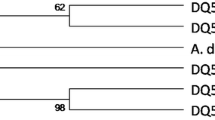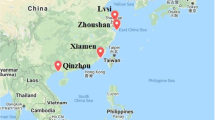Abstract
Genetic analyses using sequences of partial cytochrome c oxidase subunit 1 (cox1) gene of mitochondrial DNA were conducted to determine the extent of genetic variation within and among Xiphinema diversicaudatum, X. pachtaicum, X. simile and X. vuittenezi populations. Pairwise distance among the four species was 22.5 to 31.2%. Four different sequence variants of cox1 were determined among six populations of X. diversicaudatum and three variants among three populations of X. simile. Nucleotide variation was detected at 18 of 414 bp (1.9 to 2.7%) in X. diversicaudatum and 4 of 435 bp (0.2 to 0.9%) in X. simile. All changes were at silent sites. No nucleotide variation was detected within three populations of X. pachtaicum and within three populations of X. vuittenezi.



Similar content being viewed by others
References
Blouin, M. S., Yowell, C. A., Courtney, C. H., & Dame, J. B. (1998). Substitution bias, rapid saturation, and the use of mtDNA for nematode systematics. Molecular Biology and Evolution, 15, 1719–1727.
Derycke, S., Remerie, T., Vierstraete, A., Backeljau, T., Vanfleteren, J., Vincx, M., et al. (2005). Mitochondrial DNA variation and cryptic speciation within the free-living marine nematode Pellioditis marina. Marine Ecology Progress Series, 300, 91–103.
Derycke, S., Backeljau, T., Vlaeminck, C., Vierstraete, A., Vanfleteren, J., Vincx, M., et al. (2007). Spatiotemporal analysis of population genetic structure in Geomonhystera disjuncta (Nematoda, Monhysteridae) reveals high levels of molecular diversity. Marine Biology, 151, 1799–1812. doi:10.1007/s00227-007-0609-0.
Derycke, S., Fonseca, G., Vierstraete, A., Vanfleteren, J., Vincx, M., & Moens, T. (2008). Disentangling taxonomy within the Rhabditis (Pellioditis) marina (Nematoda, Rhabditidae) species complex using molecular and morphological tools. Zoological Journal of the Linnean Society, 152, 1–15.
He, Y., Jones, J., Armstrong, M., Lamberti, F., & Moens, M. (2005). The mitochondrial genome of Xiphinema americanum sensu stricto (Nematoda: Enoplea): considerable economization in the length and structural features of encoded genes. Journal of Molecular Evolution, 61, 819–833. doi:10.1007/s00239-005-0102-7.
Hu, M., & Gasser, R. B. (2006). Mitochondrial genomes of parasitic nematodes-progress and perspectives. Trends in Parasitology, 22, 78–84. doi:10.1016/j.pt.2005.12.003.
Hugall, A., Stanton, J., & Mortiz, C. (1997). Evolution of the AT-rich mitochondrial DNA of the root knot nematode, Meloidogyne hapla. Molecular Biology and Evolution, 14, 40–48.
Kumar, S., Tamura, K., & Nei, M. (2004). MEGA3: integrated software for molecular evolutionary genetics analysis and sequence alignment. Briefings in Bioinformatics, 5, 150–163.
Kumari, S. (2006). Xiphinema simile (Nematoda: Longidoridae) in the Czech Republic and a note on other Xiphinema species. Helminthologia, 43, 43–50.
Kumari, S. (2009). Morphometrics of Xiphinema dentatum Sturhan, 1978 from the Czech Republic. Helminthologia, 46, 201–204. doi:10.2478/s11687-009-0037-4.
Kumari, S., Polák, J., & Choutka, R. (2005). Plant-parasitic nematodes of the genus Xiphinema (Nematoda: Longidoridae) in the vineyards of the Czech Republic. Nematology, 7, 81–93.
Kumari, S., Decraemer, W., Traversa, D., & Lišková, M. (2009). Molecular and morphological delineation of Longidorus poessneckensis Altherr, 1974 (Nematoda: Dorylaimida). European Journal of Plant Pathology, 123, 125–137. doi:10.1007/s10658-008-9348-4.
Lazarova, S. S., Malloch, G., Oliveira, C. M. G., Hübschen, J., & Neilson, R. (2006). Ribosomal and mitochondrial DNA analyses of Xiphinema americanum-group populations. Journal of Nematology, 38, 404–410.
Otranto, D., Testini, G., De Luca, F., Hu, M., Shamsi, S., & Gasser, R. B. (2005). Analysis of genetic variability within Thelazia callipaeda (Nematoda: Thelazioidea) from Europe and Asia by sequencing and mutation scanning of the mitochondrial cytochrome c oxidase subunit 1 gene. Molecular and Cellular Probes, 19, 306–313. doi:10.1016/j.mcp. 2005.05.001.
Stanton, J. M., McNicol, C. D., & Steele, V. (1998). Non-manual lysis of second-stage Meloidogyne juveniles for identification of pure and mixed samples based on the polymerase chain reaction. Australasian Plant Pathology, 27, 112–115.
Acknowledgements
The authors are thankful to Dr. Haberle for preparing the map and to Dr. Lišková for providing nematodes. The work was supported by the Ministry of Agriculture of the Czech Republic, Project number MZe–0002700604.
Author information
Authors and Affiliations
Corresponding author
Rights and permissions
About this article
Cite this article
Kumari, S., Decraemer, W., De Luca, F. et al. Cytochrome c oxidase subunit 1 analysis of Xiphinema diversicaudatum, X. pachtaicum, X. simile and X. vuittenezi (Nematoda, Dorylaimida). Eur J Plant Pathol 127, 493–499 (2010). https://doi.org/10.1007/s10658-010-9614-0
Accepted:
Published:
Issue Date:
DOI: https://doi.org/10.1007/s10658-010-9614-0




